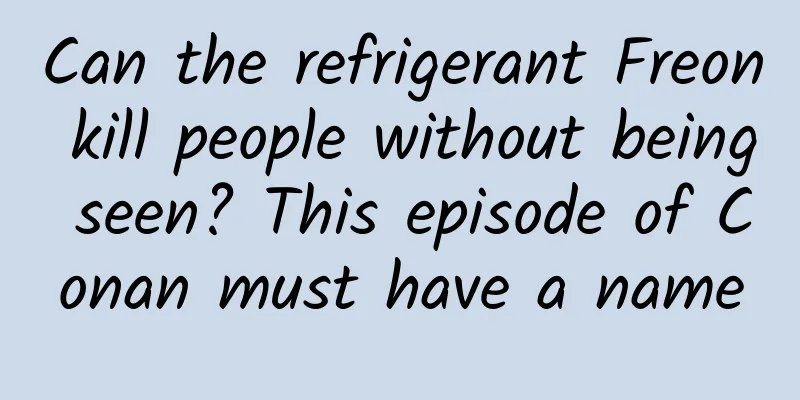Can the refrigerant Freon kill people without being seen? This episode of Conan must have a name

|
Wherever there is Conan, there is murder. What is the murder case that impressed you the most in "Detective Conan"? For example, "Flower Fragrance Murder Case"... The murderer hid the poison in the stamens and then froze the petals with the refrigerant Freon. Since everyone had to wear a brooch made of petals, when the time came, the petals thawed and bloomed, and the poison gas in the petals began to leak out, truly achieving "killing invisibly." Image source: Detective Conan Freon was once a commonly used refrigerant in air conditioners and refrigerators. Are you familiar with this name? The past and present of Freon In the 19th century, scientists used pressurized gas liquefaction and room-temperature vaporization to transfer heat energy, creating a low-temperature environment and invented the earliest refrigerant - ammonia or sulfur dioxide. Although these two substances are safe, they both have strong pungent odors, are toxic in high concentrations, and are corrosive to metals. In 1929, an ammonia leak in a refrigerator at a hospital in Cleveland, Ohio, killed more than 100 people. Soon after, American Thomas Midgley, by chance, developed a new type of refrigerant that was stable, non-flammable, non-corrosive and non-toxic. Image source: Wikipedia By studying Mendeleev's periodic table of chemical elements, Thomas discovered that some non-metallic elements on the periodic table can produce compounds that are gaseous even at room temperature, and that the flammability of these compounds also follows certain rules. For example, methane is flammable, but water and hydrogen fluoride simply cannot burn. Based on this rule, Thomas selected more suitable substances - fluorine and chlorine compounds to make new refrigerants. Through repeated experiments, a substance called dichlorodifluoromethane (CFC-12, R12) was synthesized, and a new refrigerant was born. In 1931, DuPont of the United States industrialized R12, and the name it used for trademark registration is the "Freon" we are familiar with today. Some technical terms that sound unfamiliar to us, such as chlorofluorocarbons and chlorofluorocarbons, have similar chemical properties and can be regarded as the same type of substances. Freon, the master of refrigeration Freon is not a refrigerant, but a general term for a class of refrigerants. Freon is widely used, including R11 for high temperature refrigerants, R12 and R22 for medium temperature refrigerants, R13 and R23 for low temperature refrigerants, and R14, R114, R142, etc. As a refrigerant, the refrigeration principle of Freon is not complicated. In the process of converting from liquid to gas, evaporation absorbs heat, thus achieving refrigeration. This is just like when we boil water, the hot water can only reach 100℃. If we continue to heat it, the liquid water will absorb heat and turn into gaseous water. Since Freon has a low boiling point, it can absorb and release heat better during phase transition and is mostly used in refrigerators and air conditioners. However, while providing convenience to people's lives, the chlorine- and bromine-containing halogenated hydrocarbons contained in Freon in refrigerators and air conditioners are gradually showing their destructive effects on the atmospheric ozone layer. Image source: hippopx Ozone Depletor Most of the ozone on Earth is stored in the stratosphere, which acts like a protective umbrella to protect us from ultraviolet radiation. After being emitted, CFCs stay in the troposphere and stratosphere. Freon molecules are very stable in the troposphere and hardly undergo chemical reactions. But when they rise to the stratosphere, under the strong effect of ultraviolet rays, chlorine atoms will decompose from the chlorine-containing Freon molecules and react with ozone, thereby continuously consuming ozone. Just one chlorine atom can destroy 100,000 ozone molecules. It is not only an ozone killer, but also an accomplice of the "greenhouse effect" global warming. Therefore, although the amount of Freon is small, its destructiveness is extremely great. Stratosphere, image source: hippopx In addition, Freon is highly permeable and prone to leaks, and because it has a slight odor, even a leak may be difficult to detect in time. When leaked Freon encounters open flames or the air temperature reaches 400 degrees, it may decompose into highly toxic phosgene, which will further pollute the environment. Therefore, the country has long banned the use of Freon as a refrigeration raw material. Finding the best solution among alternatives The replacement of refrigerants is gradual and has now reached the fourth generation. Since refrigerators require less refrigerant, they are relatively easy to replace. As early as 1995, isobutane (R600a) was used as a substitute in the refrigerator industry. The biggest advantage of isobutane is that it does not damage the ozone layer, but it also has a fatal characteristic: it is flammable and explosive. As a substitute for CFCs, hydrochlorofluorocarbons contain an additional chemical element, hydrogen. Although their lifespan in the air is shorter, they still contain chlorine and still deplete the ozone layer. Currently, developed countries have basically completed the elimination of this substance. Image source: hippopx It was not until after 2000 that tetrafluoroethane became a widely used refrigerant as a relatively clean energy source; in 2009, natural refrigerant propane (R290) was used as the main alternative technology for room air-conditioning refrigerants in China, but its flammability and explosion problems could not be fundamentally solved. Freon, as a refrigerant, has been gradually phased out. Now, the air conditioners in our offices or homes are increasingly using new environmentally friendly refrigerants, which not only have better cooling efficiency but also do not damage ozone. Don't worry about being deprived of the joy of summer. Pair it with a piece of iced watermelon and the joy can be doubled. END Review expert: Sun Yafei, Ph.D. in Chemistry from Tsinghua University. Tadpole Musical Notation original article/reprint please indicate the source Editor/Xiao Xitushuo |
>>: This makeup habit of girls is secretly bringing tens of thousands of bacteria
Recommend
Can't you gain weight by eating during menstruation? The more you sweat during exercise, the faster you lose weight? Don't believe these weight loss myths
Can drinking yogurt after a meal help digestion a...
Armor has good tricks · A huge number of Qianchuan advanced courses, from zero foundation to proficiency, no nonsense, practical implementation
Armor has good tricks · A huge amount of Qianchua...
Bounce off the leech that jumped onto your leg. Picking mushrooms turns out to be more stressful than "drawing blind boxes"...
If the little girl picking mushrooms walks barefo...
Microsoft's win10 and its black technology
Editor's note: Can the release of Windows 10 ...
It is popular among American mothers to cut their babies’ tongues, and they say it can “cure all diseases”?
The much-debated tongue tie. Feeding a baby is ve...
Ling'er Investment Research Diary: Golden Pit Strategy, Buy Low and Win the Golden Pit
Ling'er Investment Research Diary Gold Pit St...
Analysis of Wugumofang's private domain operations
With the development of the Internet, private dom...
Unlock advanced methods of operating WeChat public accounts!
In addition to the conventional gameplay, what el...
Key revenue indicator of media monetization - ad fill rate
If eCPM is the price of the product, then the ad ...
This little black box can crack the passcode of almost any iPhone
It doesn't matter whether you add a fingerpri...
Analyzing the creativity and marketing techniques of popular events!
What's it like to dine in a real rocket? Rece...
Archaeopteryx is not the "earliest bird" anymore? New discovery by Chinese scientists pushes back the history of bird evolution by 20 million years!
A Chinese research team recently discovered a 150...
Is breast milk no longer nutritious after 10 months? Can smoking prolong your life? Here are the scientific rumors for March
1. Alcohol and hand sanitizer can inactivate noro...
What’s more frightening than eating too much during the Chinese New Year is that the foods you thought were fat-reducing may actually be useless…
The New Year is coming soon There must be a lot o...









